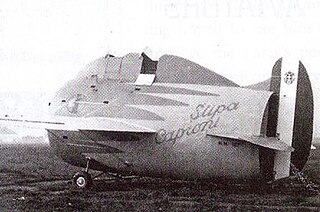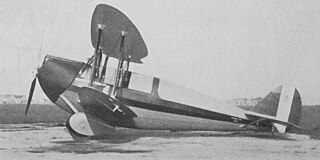| Caproni Ca.8 | |
|---|---|
 | |
| Role | pioneering aircraft |
| Manufacturer | Caproni |
| First flight | 13 June 1911 |
| Status | retired |
| Number built | 1 |
The Caproni Ca.8 was a single-seat monoplane designed and built by Caproni in the early 1910s.
| Caproni Ca.8 | |
|---|---|
 | |
| Role | pioneering aircraft |
| Manufacturer | Caproni |
| First flight | 13 June 1911 |
| Status | retired |
| Number built | 1 |
The Caproni Ca.8 was a single-seat monoplane designed and built by Caproni in the early 1910s.
The Ca.8 was a light, single-seater, single-engine aircraft, equipped with a wing in a medium-high position and with tailing in the tail. The fuselage was composed of a wooden trellis, reinforced by tie rods in a metal cable and with metal joints in turn; its front part, between the engine and the trailing edge of the wing, was covered with canvas, while the rest was uncovered. The wing, with an appreciable angle of dihedral, had in turn a wooden structure covered with canvas; it had no ailerons, and the roll control depended on a wing warping system; the deformation of the wing ends to guarantee warping was made by some tie rods which, like the bracing cables which reinforced the wing itself, were fixed to the top of a pyramidal structure located above and in front of the uncovered pilot station.
The empennages consisted of a horizontal plane placed under the fuselage and an entirely movable vertical plane hinged to the rear end of the fuselage itself. The landing gear consisted of a pair of spoked wheels placed under the front of the aircraft, to the supporting structure of which were also linked two wooden skids in anti-rollover function, and a tail skid arranged between the trailing edge of the wing and the leading edge of the horizontal tail plane.
The powertrain consisted of a fanless 3-cylinder Anzani engine with 25 hp and a fixed pitch wooden two - blade propeller, placed at the top of the aircraft in a trailing position. [1]
The Caproni Ca.8 made its first flight on June 13, 1911. It then performed a series of test flights and some public performances; the latter, performed for the benefit of spectators coming from Vizzola Ticino and the surrounding area, were highly appreciated by the public and soon became a regular appointment, which resulted in a series of elegant social occasions.
Subsequently, the Ca.8 successfully covered the role of training aircraft; the pilot school that was established under the company Ingg. De Agostini & Caproni Aviation formed about ten pilots on the Ca.8 during the summer of 1911; among them Costantino Quaglia (who participated in the Libyan campaign as an aviator), Enrico Cobioni (who later would have beaten several records and would have become the head instructor of the school), Costantino Biego (who would then command the Battalion Aviators of the Aeronautical Service ) and the Russian Costantino Akakew (who in 1921 would become the first commander of the Soviet Air Force). [2]

Data from Aeroplani Caproni – Gianni Caproni ideatore e costruttore di ali italiane [1]
General characteristics
Performance

The Caproni Ca.37 was a ground attack aircraft designed and built in Italy by Caproni around 1916

The Caproni Ca.60 Transaereo, often referred to as the Noviplano (nine-wing) or Capronissimo, was the prototype of a large nine-wing flying boat intended to become a 100-passenger transatlantic airliner. It featured eight engines and three sets of triple wings.

The Caproni Ca.1 was an experimental biplane built in Italy in 1910. It was the first aircraft to be designed and built by aviation pioneer Gianni Caproni, although he had previously collaborated with Henri Coandă on sailplane designs.

The Stipa-Caproni, also known as the Caproni Stipa, was an experimental Italian aircraft designed in 1932 by Luigi Stipa (1900–1992) and built by Caproni. It featured a hollow, barrel-shaped fuselage with the engine and propeller completely enclosed by the fuselage—in essence, the whole fuselage was a single ducted fan. Although the Regia Aeronautica was not interested in pursuing development of the Stipa-Caproni, its design influenced the development of jet propulsion.

The Caproni Ca.125 was a single-engine, tandem two-seat, touring biplane built in Italy in 1933. It could be operated either as a landplane or seaplane.

The Caproni Ca.16 was a single-engine monoplane designed and built by Caproni in the early 1910s.
The Caproni Ca.10 was a single-engine monoplane designed and built by Caproni in the early 1910s.

The Caproni Ca.9 was a single-engine monoplane designed and built by Caproni in the early 1910s.

The Caproni Ca.6 was a single-engine biplane designed and built by Caproni in the early 1910s.

The Caproni Ca.7 was a proposed biplane designed by Caproni in the early 1910s.

The Caproni Ca.22 was a single-engine monoplane made by the Italian company Aeronautica Caproni in 1913.
The Caproni Ca.25 was a single-engine monoplane made by the Italian company Aeronautica Caproni in 1914.

The Caproni Ca.11 was a single-engine monoplane designed and built by Caproni in the early 1910s.

The Caproni Ca.12 was a two-seater single-engine monoplane built by Caproni in the early 1910s.

The Caproni Ca.13 was a two-seater single-engine monoplane built by Caproni in the early 1910s.
The Caproni Ca.66 and Caproni Ca.67 were Italian night bomber aircraft designed to re-equip the post-World War I Regia Aeronautica.

The Caproni Ca.105 was a multirole high wing single engine monoplane developed by the Italian aeronautical company Aeronautica Caproni in the late 1920s.
The Caproni Ca.127 was a single-engine reconnaissance monoplane built by Caproni in the mid-1930s.
The Caproni Ca.142 was a three-engined multirole aircraft built by Caproni in the mid-1930s.

The Caproni Ca.53 was an Italian prototype light bomber built in the last months of World War I.